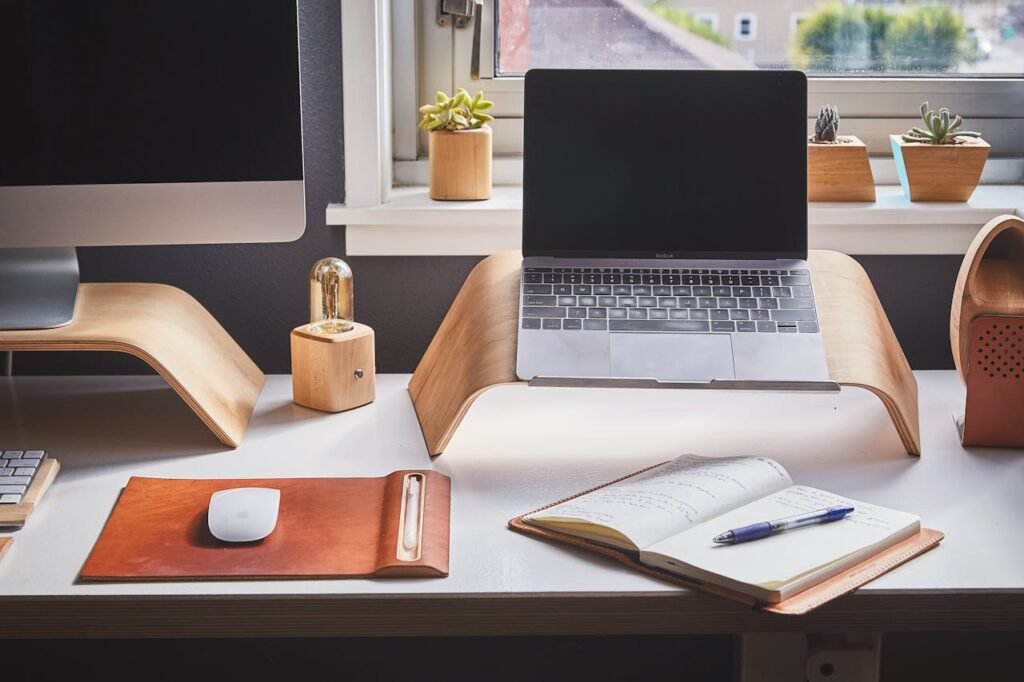Introduction
Remote work has become a significant part of our lives, and more people are starting businesses from home. This trend is turning kitchens, living rooms, and spare bedrooms into makeshift offices. A well-designed and ergonomic home office setup is crucial for productivity, comfort, and overall well-being. In this blog post, we’ll explore five essential tips to improve your home office, making it a space where you can thrive professionally.
Choose the Right Location
Finding the perfect spot for your home office is the first step toward creating a productive work environment. Ideally, your workspace should be in a quiet area away from household distractions. If possible, choose a room with a door to separate your work life from your personal life.
The location of your home office can significantly impact your productivity. Natural light, for example, can boost mood and energy levels, so consider setting up near a window. However, be mindful of potential glare on your screen and position your desk accordingly.
Minimizing distractions is essential for maintaining focus. Avoid high-traffic areas like the kitchen or living room. Instead, look for a corner or an unused room where you can create a dedicated workspace. If space is limited, consider using room dividers or curtains to create a sense of separation.
Invest in Quality Furniture and Equipment
Your home office furniture is the foundation of a comfortable and efficient workspace. Investing in high-quality furniture and equipment can make a significant difference in your workday. Start with an ergonomic chair that provides proper support for your back and encourages good posture.
Adjustable desks are another essential piece of furniture for a home office. They allow you to alternate between sitting and standing, which can reduce the risk of developing musculoskeletal issues. Look for desks with adjustable height and ample surface space for your computer, documents, and other essentials.
Proper lighting is often overlooked but is crucial for reducing eye strain and improving focus. Invest in a good desk lamp with adjustable brightness and color temperature settings. Ensure that your workspace is well-lit, combining natural light and artificial lighting to create a comfortable environment.
Organize Your Workspace for Efficiency
An organized workspace is key to maintaining productivity and focus. Start by decluttering your desk and keeping only the essentials within reach. Use storage solutions like shelves, drawers, and bins to keep everything organized and easily accessible.
A functional workspace should be both inspiring and efficient. Personalize your home office with items that motivate you, such as artwork, plants, or family photos. However, be mindful not to overdo it, as too many personal items can become distracting.
Creating a functional layout is essential for maximizing efficiency. Arrange your desk and equipment to minimize unnecessary movements. Keep frequently used items like pens, notebooks, and chargers within arm’s reach. Consider using cable management solutions to keep cords and cables organized and out of sight.
Implement Ergonomic Work Practices
Ergonomics is the science of designing a workspace that promotes comfort, efficiency, and well-being. Implementing ergonomic work practices can help prevent common issues like back pain, eye strain, and repetitive strain injuries. Start by setting up your desk and chair at the correct height.
Maintaining good posture is crucial for comfort and health. Sit with your feet flat on the floor, your knees at a 90-degree angle, and your back supported by the chair’s lumbar support. Position your computer monitor at eye level, about an arm’s length away, to reduce neck and eye strain.
Incorporate regular breaks into your work routine to stretch and move around. Aim for a short break every hour to give your eyes and muscles a rest. Simple stretches and exercises can help alleviate tension and improve circulation, keeping you comfortable throughout the day.
Personalize and Optimize for Productivity
Personalizing your home office can make it a more enjoyable and motivating place to work. Add personal touches that reflect your style and personality, such as artwork, plants, or decorative items. These elements can create a positive and inspiring atmosphere.
Optimizing your workspace for productivity involves finding the right tools and technology to support your work. Consider using productivity apps and software to manage tasks, track time, and stay organized. Tools like noise-canceling headphones can help minimize distractions and improve focus.
Experiment with different layouts and setups to find what works best for you. Some people thrive in minimalist environments, while others prefer a more vibrant and dynamic space. Listen to your preferences and adjust your workspace to suit your needs and enhance your productivity.
Conclusion
Improving your home office setup can have a profound impact on your productivity, comfort, and overall well-being. By choosing the right location, investing in quality furniture and equipment, organizing your workspace, implementing ergonomic work practices, and personalizing your space, you can create a home office that supports your professional goals.
Remember, small changes can make a big difference. Start with one or two tips and gradually implement more as you see fit. Share your own home office improvement tips in the comments below. Together, we can create inspiring and efficient workspaces that help us thrive in the remote work era.

